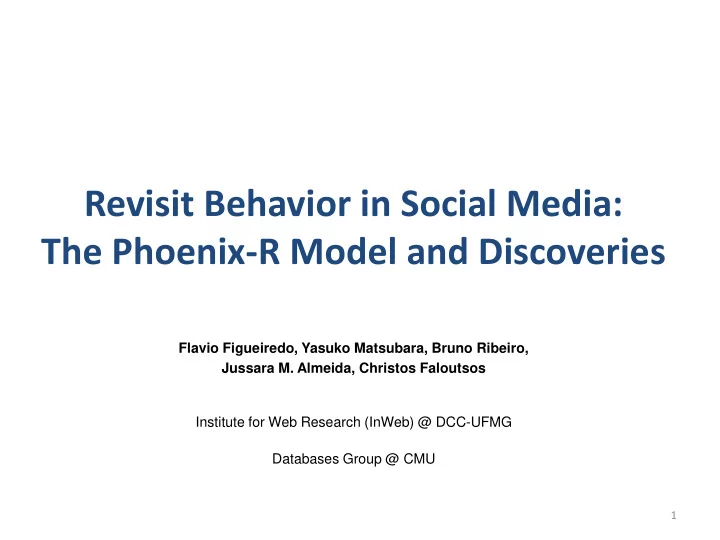

Revisit Behavior in Social Media: The Phoenix-R Model and Discoveries Flavio Figueiredo, Yasuko Matsubara, Bruno Ribeiro, Jussara M. Almeida, Christos Faloutsos Institute for Web Research (InWeb) @ DCC-UFMG Databases Group @ CMU 1
How should we account and model information popularity online? 2
How should we account and model information popularity online? 3
Audience: Unique users 4
Audience vs Visits Multiple Visits from the Same Users 5
Measuring both visits and audience (unique users) have their benefits • How many users watched my ad? – Exposure – Revenue • How many times was my ad watched? – Caching – Sharding and content provisioning • However… – Understanding and modeling both effects is still an open issue 6
Our Study • Understanding and modeling revisit behavior in social media • Understanding – Characterization of millions of user activities – User played/watched/visited a social media object at a certain time • Modeling – The Phoenix-R model for popularity time series 7
Datasets • User Activity – User, Object (song/tweet/video), Time stamp • All of the datasets range from months to years Dataset User Activities Description MMTweet Little over 1 million Tweets declaring (Million Musical songs which users Tweets) listen to Twitter 576 million Hashtags LastFM 19 million Plays on artists and songs YouTube - 3 million daily time series 8
Discoveries 9
Discoveries • Relationships between audience (unique users) and revisits Median Median % of cases Dataset #𝑺𝒇𝒘𝒋𝒕𝒋𝒖𝒕 #𝑺𝒇𝒘𝒋𝒕𝒋𝒖𝒕 # 𝑺𝒇𝒘𝒋𝒕𝒋𝒖𝒕 > #𝑩𝒗𝒆𝒋𝒇𝒐𝒅𝒇 #𝑼𝒑𝒖𝒃𝒎 𝑾𝒋𝒕𝒋𝒖𝒕 # 𝑩𝒗𝒆𝒋𝒇𝒐𝒅𝒇 MMTweet 0.68 0.40 33% Twitter 1.70 0.62 66% LastFM 25.39 0.96 100% 10
Discoveries on Smaller time Scales • Isolate the effect of users coming back to the datasets after long periods • Daily Time Windows Median Dataset #𝑺𝒇𝒘𝒋𝒕𝒋𝒖𝒕 #𝑩𝒗𝒆𝒋𝒇𝒐𝒅𝒇 MMTweet 0.83 Twitter 2.50 LastFM 28.0 11
What we know so far • Users revisit the same object – On some datasets (LastFM and Twitter) most of visits are returning users • Revisits are common on small time scales – Above results hold – Complements [Anderson2014] • Users abandon content but it may take a long time – Preying behavior from [Ribeiro2014] 12
Users eventually stop visiting Decay in popularity in one of the most popular songs last year 13
Some objects behave like a sum of multiple cascades Multiple cascade (spike) like behavior in a very popular music song 14
How de we model these time series? 15
The Phoenix-R Model! 16
Phoenix-R Explained • Single shock (cascade) model • Epidemiology model 17
Single Shock • Starting with some Susceptible and Infected Individuals • The Infected access the content 18
Single Shock • At the next time tick some Infected recover • Some Susceptible are infected by the previous infected • We now expect more visits (more infected) 19
Single Shock Equations 20
Multiple Shocks • Simplifying assumption that each shock is a new population (set of users) 21
How many shocks to add? • A perfect model (zero error) can be created by – Letting each access be a single user which immediately recovers – However, lot’s of parameters (cost) • Using Minimum Description Length (MDL) 22
How do we fit a time series? • Step 1: – Identify Peaks using Wavelets – Intuitively, each peak is a candidate shock (cascade) – Linear • Step 2: – Add each peak sorted by height to the model – If the MDL decreases, accept peak • Step 3: – Stop when the MDL stops decreasing 23
Linear runtime (time series length) and parameter free algorithm Find Peaks Adding shocks Exit 24
How good is Phoenix-R? • Comparing Phoenix-R with two state of the art alternatives – RMSE (smaller is better) • Phoenix-R is always better or just as good 25
How good is Phoenix-R? • Comparing Phoenix-R with two state of the art alternatives – RMSE (smaller is better) • Phoenix-R is always better or just as good 26
Phoenix-R is also good at forecasting • RMSE (smaller is better) • 1, 7 or 30 days ahead forecasting • Ties on very linear time series 27
Phoenix-R is also good at forecasting • RMSE (smaller is better) • 1, 7 or 30 days ahead forecasting • Ties on very linear time series 28
Examples of Phoenix-R at work 29
Examples of Phoenix-R at work 30
Conclusions • Phoenix-R model for revisits and multiple cascades • Based on discoveries from real data • Scalable linear fitting algorithm – On time series length • Useful for predictions 31
Recommend
More recommend